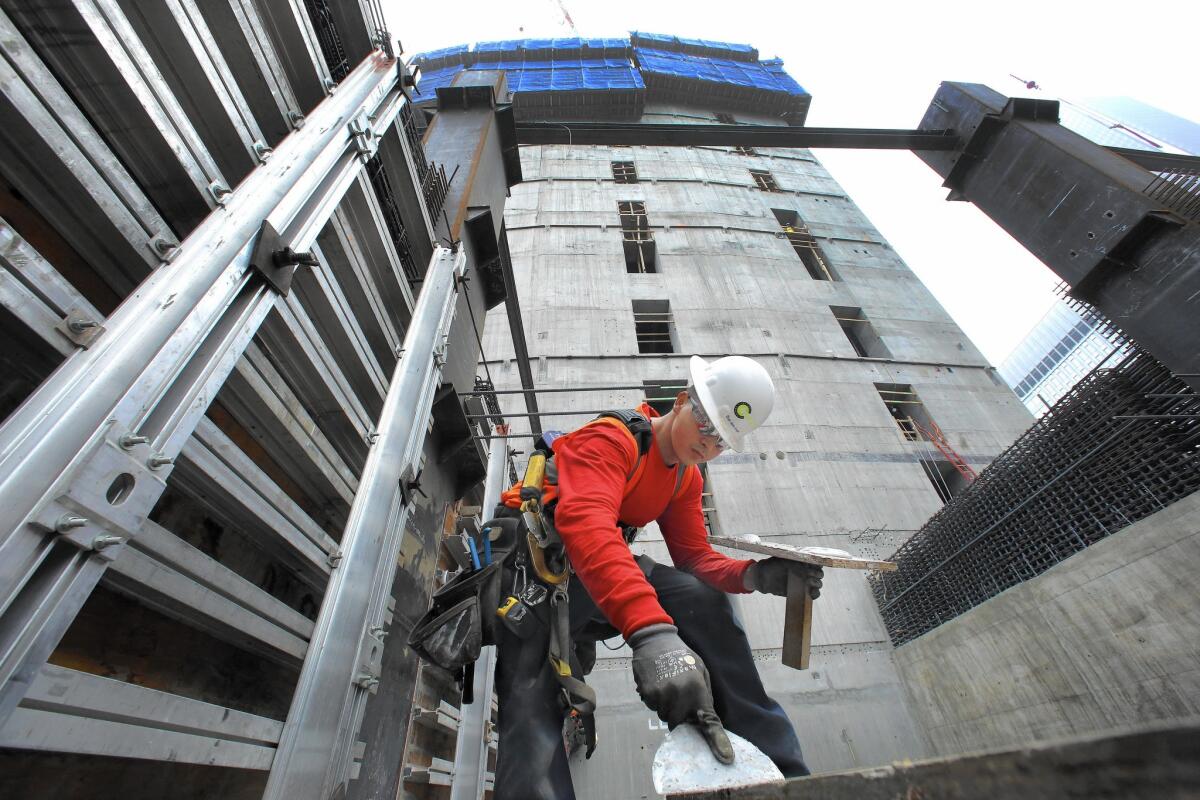Can California’s economy keep its momentum?

As head of the Los Angeles office of global engineering firm Arup, Jon Phillips has a panoramic view of the economy — through his diverse array of clients.
When the real estate market crashed in 2007 and 2008, the firm shifted a significant chunk of business overseas to projects in China and the Middle East. Now the focus is almost entirely domestic, with a slate of high-profile local projects including a budding tech campus in Playa Vista, a sprawling new Kaiser hospital in San Diego and the design of Metro’s Crenshaw/LAX light-rail line.
“I see quite a healthy confidence” in the regional economy, Phillips said. “New inquiries are higher than they have been at any point in recent years.”
Judging from just about every major indicator — including job growth, construction permits and auto sales — California’s economy is churning at one of the fastest clips of any state over the last few years. After being one of the hardest-hit by the housing bust and the Great Recession, the state has come roaring back, outperforming the nation in job and gross domestic product growth for much of the last three years.
But as slowing growth in China prompted panic in U.S. financial markets this month, it rekindled memories of tougher economic times — the instability of markets during the recession and early years of the recovery. After falling harder than most regions, the California economy has been one of the brightest spots in the U.S. economy — currently the most stable in the world — and experts say the underlying fundamentals point to continued growth.
Whether California can maintain that momentum is a more complicated question. Historically, the Golden State has been more volatile through boom-and-bust cycles of the economy. It tends to fall harder than the rest of the nation during recessions and climb higher during expansions.
More to the point: History shows that the rosiest projections from economists and business leaders often come directly before a meltdown, as with the 2008 financial crisis. Only in hindsight do the causes seem obvious.
In 1998, it was an emerging-market debt crisis that almost no one saw coming or expected to be so severe. Nervousness about the health of emerging-market economies — not just China — contributed to the gyrations in the market last week, and there is still concern about vulnerabilities in those markets, in part because of debt levels.
The recovery from the 2008 crisis looked bleak in 2010 and 2011, but the economy has been expanding, by the technical definition, for more than six years now. The average length of economic expansions since World War II has been about seven years — suggesting the state may be due for a shock.
“It’s going to be a lot harder for California to outperform the way it has the last two years,” said Scott Anderson, chief economist at Bank of the West in San Francisco. “It doesn’t mean we have to go into a recession, but it does make it a lot harder for us to keep up this pace.”
The wild gyrations in the stock market last week have been jarring — coming just months after major indexes reached historic highs. But economists cautioned that such losses would have to be sustained over many months to derail progress in the wider economy.
“The financial markets are like a yo-yo. It’s going to go up and down,” said Esmael Adibi, director of the A. Gary Anderson Center for Economic Research at Chapman University. “The real economy is like a ship. It’s going to take it quite a long time to make a turnaround, or to slow down.”
Even as markets swung wildly throughout last week, a series of government indicators — consumer confidence, new-home sales and GDP growth — all pointed to continued momentum.
Trends in purchases of homes and automobiles tend to be more directly tied to the health of the job market, which in California has been growing at a rate of about 3% in each of the last three years, faster than the U.S. average of around 2% annually over the same period.
NEWSLETTER: Get the day’s top headlines from Times Editor Davan Maharaj >>
In addition, the labor force in California over the last year has grown faster than the national average — a sign that workers feel more comfortable about their job prospects.
Investors would have to take severe and sustained hits in the stock market to cause enough fear to would ripple into the California economy, experts said. That phenomenon — known as a “negative wealth effect” — is a psychological effect that takes hold when investors feel less prosperous because of stock market declines, prompting a pullback in spending that affects decisions about future business expansion and hiring.
If that were to happen — and most economists still say that’s a big “if” based on last week’s ups and downs — California could potentially be more exposed to such a slowdown.
Much of the historic volatility in the California economy owes to the state’s heavier dependence on real estate, which is more expensive in California, and much more prone to slowdowns when job growth stalls.
The state is also ground zero for venture capital funding that has fueled the tech boom and made the San Francisco Bay Area one of the hottest job markets in the nation. Over the last five years, about 56% of the nation’s venture capital funding has happened in California.
If uncertainty were to continue in the financial markets, investors could be less willing to commit to as many start-ups.
“What we’re seeing is a growing aversion to risk, and that’s not good for any industry that is dependent upon the continued inflow of capital,” said Mark Vitner, a senior economist at Wells Fargo who tracks regional economic trends. “It could be tougher for less apparent, or less certain ventures to attract capital.”
Aside from China’s effect on U.S. financial markets, California could also be more exposed to a slowdown in Chinese consumption than other parts of the country — given the huge upswings in tourism and real estate investments from China.
“California is a bridge between Asia and the rest of the U.S.,” said Sung Won Sohn, an economics professor at Cal State Channel Islands. “We have gained in the past, and we could stand to lose more as a result of what’s happening in China and elsewhere.”
But Sohn said that while much has been made of recent Chinese real estate investment in Southern California, any slowdown would not be enough to have a significant effect on the state’s wider economy.
“We are really talking about tributaries here, not the mainstream,” he said.
The same goes for any slowdown in consumption of U.S. goods within China. Though China is one of the fastest-growing export markets for U.S. goods, that trade flow represents only about 1% of the nation’s GDP.
That makes the U.S. much less exposed than economies such as Brazil and Australia, which grew rapidly by selling commodities such as iron ore and coal to China.
The ports of Los Angeles and Long Beach are seeing record volumes of goods this year, but the vast majority of that trade is imports — driven by the growing purchasing power of American consumers. Jobs tied to goods movement — including warehouse workers, truck drivers and purchasing managers — are expected to continue growing if consumer confidence and a stronger dollar persist.
Jim Madrid, who runs business development for construction firm McCarthy Building Cos. in Southern California, said the potential slowdown in China hasn’t given his company much pause. He’s in the midst of planning sessions for 2016 now, and is expecting a 50% increase in targeted revenue for projects next year.
The firm might have pursued more projects with Chinese investors if the market were tight, but he said local clients have provided plenty of future opportunities — including a tram at LAX and construction of a new downtown jail for Los Angeles County inmates.
“Maybe in a month we’ll see where the market’s at, and maybe see whether it’s something bigger,” Madrid said. “But I look at the $6 billion worth of opportunities we’ve targeted for 2016, and I think very, very few could be impacted.”
ALSO:
Will Wall Street turmoil affect Southern California housing market?
Here’s why drugmakers are held in low esteem
More to Read
Inside the business of entertainment
The Wide Shot brings you news, analysis and insights on everything from streaming wars to production — and what it all means for the future.
You may occasionally receive promotional content from the Los Angeles Times.











